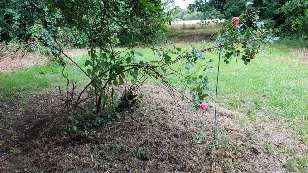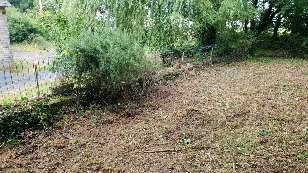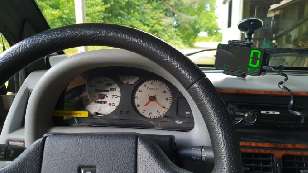Rick's b.log - 2020/06/12
You are 3.138.105.4, pleased to meet you!
Rick's b.log - 2020/06/12 |
|
| It is the 21st of November 2024 You are 3.138.105.4, pleased to meet you! |
|
mailto: blog -at- heyrick -dot- eu
They all replied that it was simple. "Rouvrir" was not a French word. The word that I should use is "réouvrir", and "rouvrir"... is gibberish.
So I walked to where the newspapers were, and held up this one:
"B-but!", they said, "It's not a French word", they said, while staring at the word written in big letters on the headline of the front page of a French language newspaper that is so French that it contains the name of the country in the title.
For the omission of all doubt: When I say "Bloody French", I'm referring to the language, not the people.
The first thing was to cut down the dead pear tree and remove the parts of it. I also took off some of the low hanging branches of the gage and some of the dead branches of the oak. There's a big rose there, I'm not entirely sure why mom planted it there, but there it is. I think it'll need to be cut back...
Another job that needed done was to clear off the front wall which was a mess of nettle and bramble. That was done, and the oversized rosemary cut back so it isn't taking over several metres of the wall. There's now basically the big rosemary and two more roses. One to the far left of the photo, the other near the far end of the fence.
Most of the metal uprights are no longer attached to the wall. They've rusted and broken. If you look at the upright to the right of the rosemary, you might see a big rock holding the fence upright.
What was stranger was that Felicity struggled to get up to the usual 45 at all in the recent heatwave. What?
I'm not sure why this is happening. I mean, I'd totally understand a sluggish speedometer in the cold. Oil stiffer, blah blah. But in the heat?
Anyway, I had the idea of building myself a GPS speedometer to use independently of the swing-needle mechanical speedometer. Which was actually working correctly now, since it's cooler and wetter.
But I threw all those plans away. I guessed getting all the bits, and a box to put it in, would probably cost me in the order of fifty euros.
There are essentially two types of add-on speedometer available for a car. The first hooks into the ODB port to retrieve all sorts of information from the engine management system. The second type doesn't need any connections to the car other than a power supply - useful for vehicles that don't have any sort of engine management.
Here it is:
The speedometer comes with a fragile looking stick-on mount, so I've simply fitted it into the mobile phone holder. The display is a little dim in the daylight (there's a light sensor on the back, but it's obscured by the holder), but one cannot deny that the speed display is large enough to be seen at a glance. I'll have to see how it works out in practice, if it can be seen in sunlight or if I'll need to break the thing open and solder the light sensor to some wires so it can sit on top of the device.
The big digit is the speed. This can be shown in kilometres per hour, or miles per hour. There are three digits along the bottom. The one on the left is the driving time of the current journey. The unit will apparently beep every hour to warn you if you're getting tired. The middle number is the distance for the current journey. The rightmost is a multiple purpose number. It will flash the total distance recorded (all journeys) when there's no GPS or when the vehicle stops (alternating with the current time). When GPS is locked in, it will show the altitude. You can have it show the current time instead.
The settings are interesting. Pressing the wheel-thingy shows a number on the display, from
The first setting is an over-speed alarm. The default is 120kph. I've set mine to 50kph (although with a tailwind and downhill, Felicity can barely manage faster).
Other options - press and hold the wheel button to switch between KM or ML distance units.
And, well, that's it.
I just took Felicity up the lane (and back) to collect the dustbin (yikes, it's quarter past eleven!? I didn't realise, the sun didn't set that long ago, oops!).
Oh, and it's decided that I'm 84 metres up. Which is pretty much spot on, especially considering my S9 thinks it's 108.
Bloody French (language)
As I work daytime hours, I tend to have lunch around the same time as the management. So the other day I asked (writing it all down so there was no problem with my pronunciation).
I asked:

More in the potager
I did some work in the potager, tameification if you will, during the evenings after coming home from work. Just little bits here and there, to add up to changes by the end of the week.


I'll have to have a think about what to do about this. I'm in no rush, it's been like that for a decade. Give me some time to work out if it would be best to replace the uprights, and if so, with what. And how. I suspect it may involve drilling/breaking out the old uprights (embedded in the concrete) and cementing in new ones.
GPS speedometer - C80
I know that Felicity lacks acceleration on damp days before she's warmed up. Today was a damp rainy miserable morning (after a night like that). Felicity struggled to get up to 30kph going up a hill just after the end of my driveway, and managed to crawl up to 40kph downhill. She was better by the time I made it to the forest, once all the spinny bits had warmed up and dried off.
I felt a little embarrassed crawling down the road at 42kph, with my foot to the floor. That was until I passed a speed display gizmo that told me that I was actually speeding - doing 51kph (that's about her maximum).
I hooked up my phone and used the GPS speedometer app, and observed on the really hot days that the speedometer was "about right" at 30kph, but started to drop off after that point, to end up about 9kph slow at the expected driving speed. Which was, actually, quite a lot.
On the face of it, it's a fairly simple task. I would need some sort of programmable microcontroller, such as the ESP32 or ESP8266. Well, I don't need WiFi so any old Arduino would work, but those are the devices that I have kicking around.
The GPS receiver would be a generic GPS module. These basically look after themselves and periodically output NMEA format data via serial, and the one I played with a while back output the recorded speed in kph. So basically all the microcontroller just needs to do is wait for the data, parse it, and display it. To be honest, an ESP-anything would be overkill for this purpose.
The hard part would be interfacing to a display. A 1602 LCD would be right out, even with a backlight (useful), it's just too small to be seen when driving. I had my doubts about OLED panels too. I might be able to make up a bitmapped display - let's face it, it only needs to be two digits. That would fit on an inch sized OLED and might even be large enough to be seen - but would the OLED be bright enough to be seen?
I suspected that I'd need to go old-school and hook a dual 7-segment LED to some latches or something, plus I/O decoding to reduce the number of I/O ports required.
Obviously, since the software would probably be about twenty lines, I thought about additional "features", such as a beeper that could warn me when approaching the two 30kph zones on my way to work, and beeping if I go faster. In that way, I pretty much wouldn't even need to look at the speedometer, just let the beeps be my guide.
As it happens, there is such as thing as a GPS speedometer. It cost €22 and I ordered it on the 29th of May. Amazon said I'd get it (from China) between the 11th and 22nd of July.
It arrived today.
Since Felicity's management is, well, my foot... I needed the GPS version.

It was pretty quick at locking into GPS. The three times I powered up, it took between 15 and 45 seconds.
I took a quick drive on the driveway, and it seemed reasonably responsive. I'll need to go for a proper drive with the GPS app on my phone to see if agrees. It should...
You can switch all of this extra stuff off, to have only the speed showing.
001 to 005. Rotating the wheel up and down alters the setting.
Next, you can set an adjustment to the speed if you want it to under-read or over-read. Traditional speedometers tend to over-read slightly, so this could be used to mimic that? It could also be used to provide correction if the speed display is out - although I'd wonder why a GPS speed would be out.
The third setting, the altitude value calibration is... bizarre. It told me I was anything from 98 to 122 metres up. My actual height is almost exactly 80 metres (OSM and Google agree). While GPS locations tend to be accurate enough to mark what side of the road I'm on, they seem to be a lot less accurate when it comes to how high up. The setting is 750-950 (default 850) in steps of 5 metres. What? I'm not 850 metres up! I started up my old S7 as it has the GPS Toolbox app, and that said I was 98-106 metres above sea level (and couldn't decide which).
The final setting is for adjusting the time. By default, it gives UTC. The instructions say that the settings are +/- 90 minutes, which is useless for most of the planet. What actually happens is that each number adds or subtracts half an hour from the UTC time. For some inexplicable reason, the +/- is back to front. I've set my time adjustment to "-4" which adds four half hours, or the two hours as expected between UTC and CEST.
You might have noticed that I said '005' above. Calling up setting 5 and holding the rotating button downwards for a few seconds will perform a factory reset (also clears the total recorded distance).
Rotate the wheel up and hold to toggle whether all information is visible, or if it's only the speed shown.
Rotate the wheel down and hold to choose whether the current time or the altitude is displayed on the lower right corner when the car is moving.
I didn't get up any real speed (about 22kph max) and in observing, it mostly agreed with my phone, with two differences.
The first difference was that I noticed that there was a hiccup when my reported speed (about 16 at the time) suddenly dropped to 5, then 3, then back to 16. My actual speed didn't change. This might have been due to a hiccup in GPS reception? I'll need more testing to see if this is a one off or if it happens frequently.
The second difference is that it is a lot more responsive. When I speed up and slow down, it shows on the GPS gizmo almost as it shows on the real speedometer. My phone? Takes a few seconds to notice. I'm guessing my phone may do something like collect and analyse multiple readings, rejecting obvious rubbish, and possibly averaging out minor variations. So that would mean the app is immune to glitches, at the expense of being less responsive. Having said that, speeding up and slowing down take time, so I didn't really notice any big lag when using my phone as a speedometer when the mechanical one was broken. It will be interesting to observe something that provides a more immediate speed report.
David Pilling, 25th June 2020, 16:00
| © 2020 Rick Murray |
This web page is licenced for your personal, private, non-commercial use only. No automated processing by advertising systems is permitted. RIPA notice: No consent is given for interception of page transmission. |